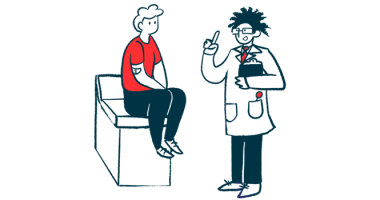The importance of telehealth grows as my husband’s ALS progresses
We need more accessible options for patients who can't travel

As my husband Todd’s ALS progressed, trips to the doctor’s office became increasingly difficult. When he was still walking, we used to travel four hours from northern Michigan through Wisconsin to the closest ALS clinic in Duluth, Minnesota. We turned those trips into mini-vacations, bringing the kids along and meeting up with Todd’s family. The kids enjoyed swimming in the hotel pool, eating out, and visiting a toy store. We toured the North Shore of Lake Superior and visited Gooseberry Falls State Park.
We found value in meeting with the different specialists, and we were able to attend an ALS support group. We always learned something that made the trip worthwhile.
We continued going to the Duluth clinic even after Todd was in a wheelchair. We made arrangements for a Hoyer floor lift to be available at the hotel, and I’d use that to transfer Todd into bed and onto the toilet. But as valuable as the clinic was, the ride to get there became too difficult.
I inquired about using telehealth, but the neurologist didn’t have a license to practice in Michigan. So I contacted an ALS clinic in Michigan, but was told that we’d first need to have an in-person visit. If we couldn’t make a four-hour trip to Duluth, we certainly couldn’t travel eight hours downstate. And even if we could have established a relationship in person, telehealth might not have been practical, because back in 2016, we didn’t have reliable internet at our home.
With Todd unable to travel far, we established relationships with local doctors. They didn’t specialize in ALS but were willing to work with us on possible solutions for his care, often based on information I had learned from the broader ALS community on social media.
But ALS is relentless, and Todd’s disease has progressed so that even traveling five minutes into town is difficult, especially during the winter months with the cold and snow.
Every year in January, Todd requires a doctor to verify that he’s still disabled so that he can continue to receive his long-term disability benefits. At his appointment last year, his head bounced around as I drove carefully down our snow-packed driveway. The clinic parking lot was even worse, with deep ruts from cars driving over the snow before the plows came through. It was miserable for him.
We mentioned the challenge of getting there, and Todd’s doctor said there was no reason we couldn’t schedule a telehealth visit for the following year. Telehealth had expanded as a result of the pandemic, and with high-speed internet services like Starlink, it is now technologically feasible for even the most rural customers.
Expanding access to healthcare
Last week, we had our first doctor appointment via a video conference call. It was so easy. A couple days ahead of the appointment, I stopped by the office to drop off the disability paperwork and update Todd’s insurance information. On the day of the appointment, the doctor’s office texted a Zoom link. At 2:30 p.m., the office texted again to let us know that the doctor was running about 10 minutes behind. It was nice to be at home and not waiting in the exam room. After connecting to the Zoom call, we went through our list of concerns, and the doctor addressed each of them.
Access to telehealth in the United States varies, as rules are different in each state. Michigan, for example, usually requires telehealth doctors to be licensed by the state. A number of exceptions are listed, but none that would allow Todd to use telehealth to meet with the ALS specialist he saw in Duluth.
It would be preferable to continue seeing the doctor we got to know in person, but it may now be possible to establish a doctor-patient relationship without having to first travel downstate. This morning, I reached out to an ALS clinic in Michigan that’s about eight hours from us and learned that if we can get a local doctor’s referral, and if we submit Todd’s medical records (including those from the ALS clinic in Minnesota), a clinical physician will review the information and consider accepting Todd as a patient.
I’m hopeful that telehealth will continue to expand and make accessing specialized healthcare easier for rural patients, especially those who can’t travel.
Note: ALS News Today is strictly a news and information website about the disease. It does not provide medical advice, diagnosis, or treatment. This content is not intended to be a substitute for professional medical advice, diagnosis, or treatment. Always seek the advice of your physician or other qualified health provider with any questions you may have regarding a medical condition. Never disregard professional medical advice or delay in seeking it because of something you have read on this website. The opinions expressed in this column are not those of ALS News Today or its parent company, BioNews, and are intended to spark discussion about issues pertaining to ALS.








Comments
Russell Eugene Congrove
My wife has been diagnosed with ALS. She has trouble speaking and swallowing. It has been 9 months since she showed signs of it and it has not moved in that nine months. I have no idea what to do for her or where to go for more help. I have been reading about Telehealth is that a source I should go to for help. She is seeing some very good Doctors and Ohio State. They have tested her and are keeping us informed of what is going on with her disease. I want to do more and to help her as best as I can. I don't have a clue what to do for her. Is there any place I can go to for help in caring for her. She is able to get around well now but I want to know what to do when she is unable to. Any help would be welcome I just need more information on what I can do for her.
Thank You for reading this